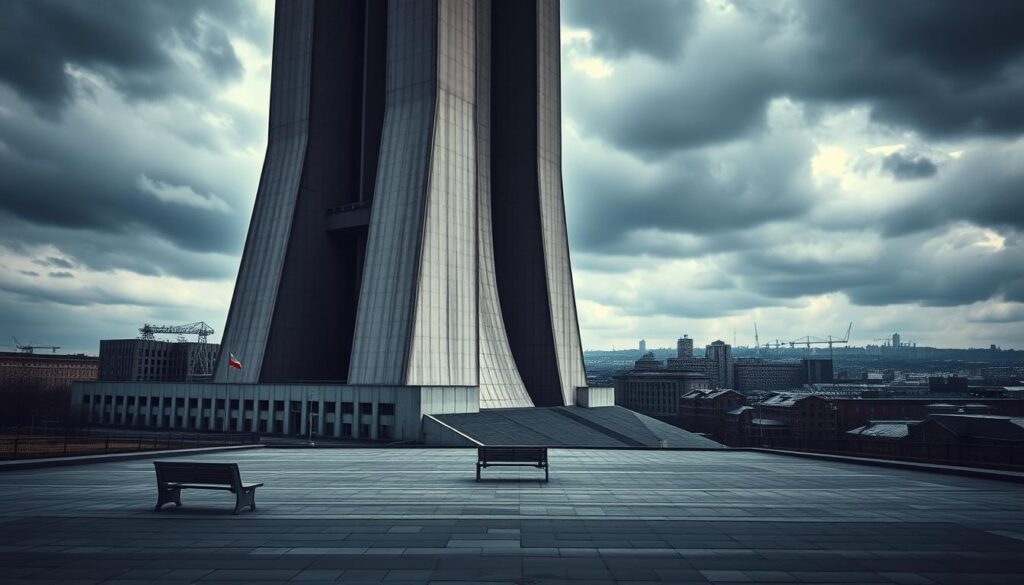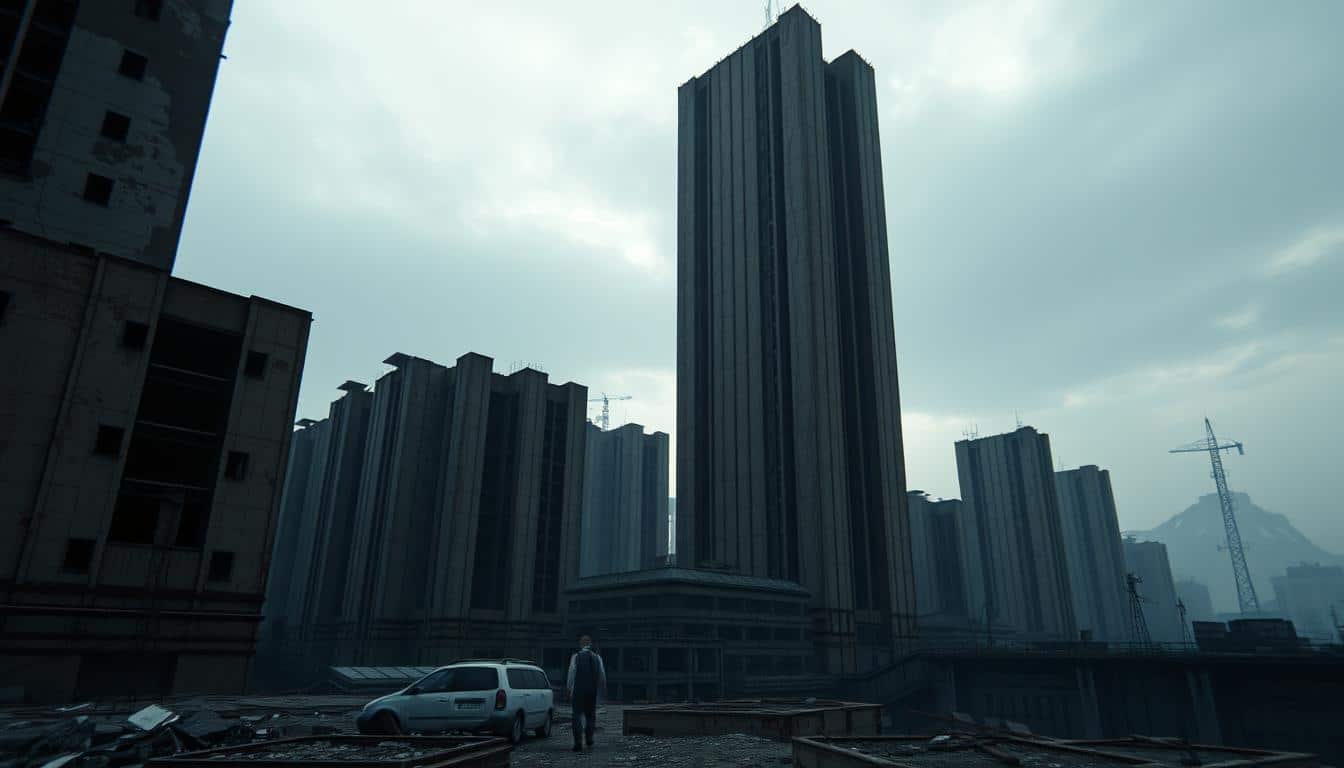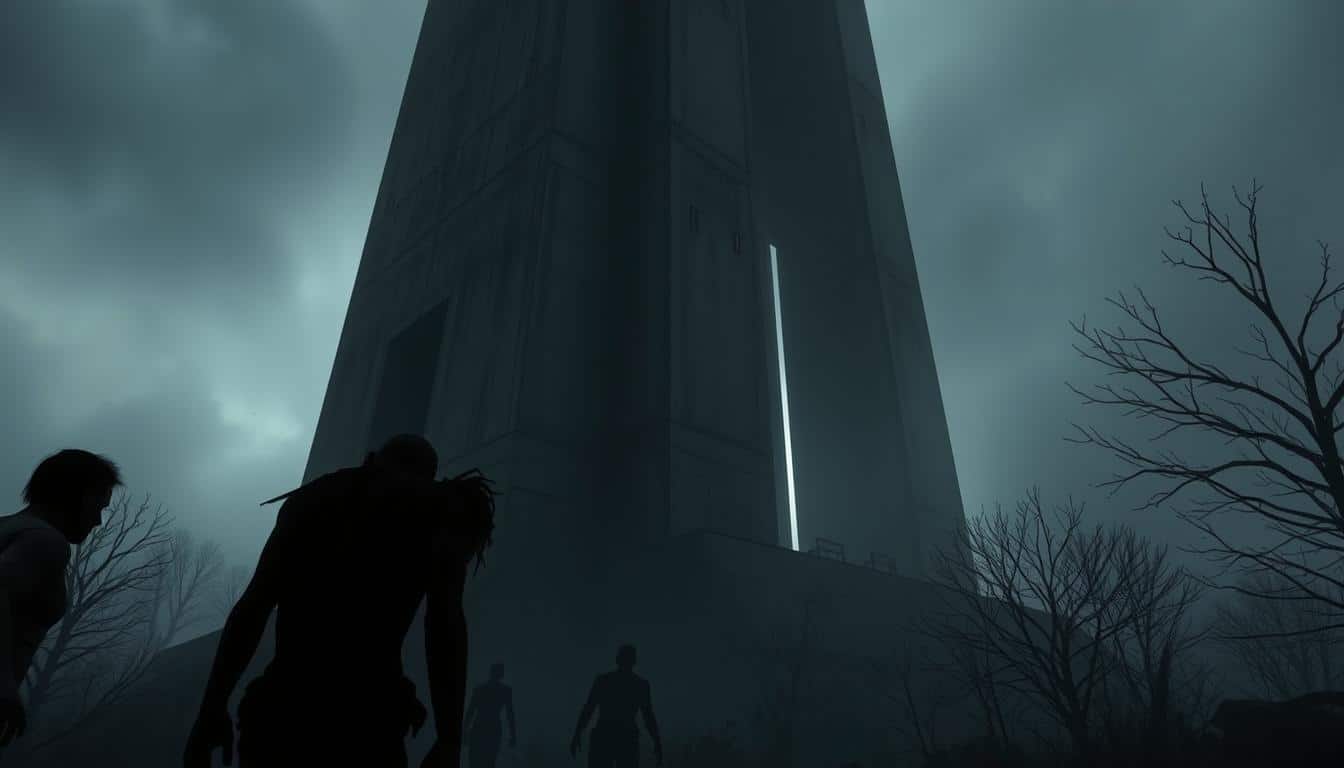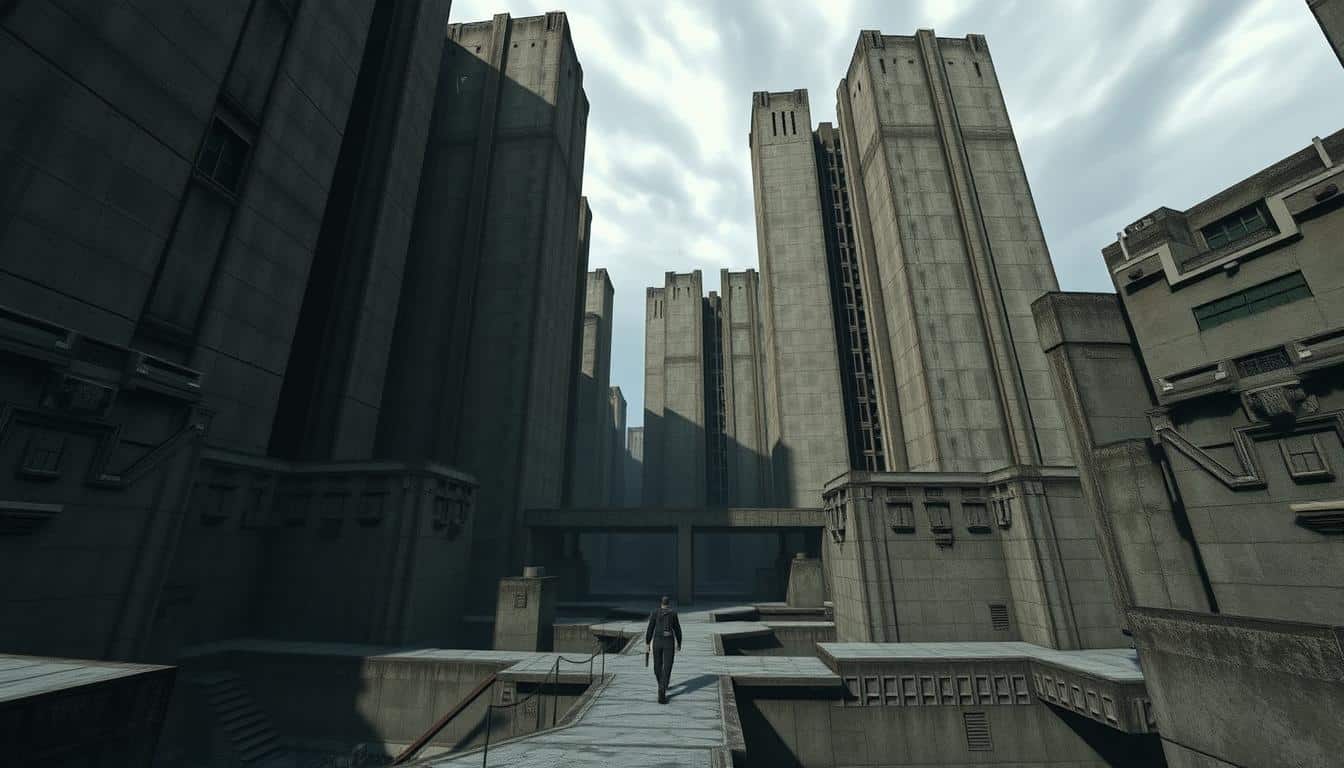Soviet Brutalism emerged after World War II. It’s known for its raw concrete look and stark shapes. In this journey, we’ll see how this style lives on in digital worlds. It shows the style’s lasting importance and its role in today’s cultural talks.
The Essence of Soviet Brutalism
Soviet Brutalism came to life after World War II. The Soviet Union had to rebuild and wanted to use architecture to shape society. This movement’s heart came from its use of concrete. Concrete showed strength and bouncing back from tough times. It also made the Soviet Union’s ideas visible, tying them to the hopes of a new world.
Historical Context and Origins
After the war, the Soviet Union needed to rebuild quickly and cheaply. That’s why concrete became so popular. But it wasn’t just about being practical. It was also a way to show what the state believed in. It put the group above the single person and usefulness above fancy designs.
Key Characteristics of Brutalist Architecture
Brutalist architecture is easy to spot because of its bold use of concrete. It stands out with its:
- Monumental scale that inspires awe and instills a sense of power.
- Functional forms devoid of decorative elements, aligning with utilitarian principles.
- A focus on the authenticity of materials, emphasizing the rawness of concrete.
This style shows Soviet ideology in its form and function. It highlights their values of strength, togetherness, and purpose.

Exploring Soviet Brutalism in Virtual Worlds
Bringing Soviet Brutalist architecture into digital spaces is becoming popular in gaming and virtual design. Players now experience these iconic designs in immersive ways that were not possible before. They don’t just see the Brutalism style; they interact with it, learning about it dynamically.
Understanding the Digital Recreation
Games and simulations are now using Soviet Brutalist architecture, turning them into playable areas. These digital versions keep the buildings’ history alive and let players explore and interact with them. This interaction creates a unique feeling and improves the gaming experience.
The Transformative Power of Virtual Environments
When gamers explore these digital worlds, they get a deep look at the art and ideas of these buildings. They see the greatness and harsh realities of the time, changing how they think about Brutalism. This move from real to virtual spaces opens up new views on architecture and its role in digital media.
The Role of Architecture in Video Games
Architecture in video games plays a key role. It shapes how we play and experience stories. Different architectural styles impact player interaction and decision-making. This helps create emotional responses as we explore gaming worlds. Understanding architectural design deepens our engagement in dystopian environments.
How Architectural Styles Influence Gameplay
Architectural styles shape gameplay in significant ways. Building layouts, visual styles, and themes influence how we feel and act in the game. They guide player behaviors through:
- The spatial arrangement that determines movement pathways.
- The visual cues that suggest potential threats or opportunities.
- The narrative context conveyed through architectural details.
These design elements are crucial for immersive play. They show how architecture directs player interaction.
Case Studies on Dystopian Cities
Looking at “Dishonored” and “Fallout” shows architecture’s effect on game tone and experience. Here are some findings:
- “Dishonored” mixes Victorian and industrial styles. This evokes a feel of oppression and impacts strategies.
- “Fallout” uses Brutalist architecture. It sets a scene of nuclear ruin, with survival and moral choices at its core.
These examples highlight architecture’s role in storytelling. It draws players in, making design a key part of creating games.
Brutalism: A Cultural Artifact
Brutalism is a key cultural artifact that shows the heart of Soviet thinking and goals. This style wanted to express strength and unity during a time full of political and social change. Brutalist buildings aimed to build a common identity, pushing the idea that society’s growth is more important than personal gain.
Brutalism as a Reflection of Soviet Ideology
Brutalism was closely linked with the Soviet dream of a new society. The use of raw materials like concrete showed the value of the people’s work. Its main features were:
- Big concrete shapes that showed stability
- Simple designs that put function first
- Open areas for community activities and talks
This style echoed the Soviet Union’s hopes, showing power and endurance against tough times.
Modern Interpretations and Neo-Brutalism
Nowadays, there’s a growing interest in Brutalism again, seen through Neo-Brutalism. Modern designers are applying these ideas to solve current social and economic issues. Neo-Brutalism’s qualities are:
- Updating old Brutalist buildings for today’s use
- Mixing in eco-friendly design
- Focusing on spaces for the community
The new take on Brutalism shows a deeper appreciation of our architectural past, linking history with the present. As architects dig into Neo-Brutalism, they keep connecting with the deep meanings in this powerful style.
Video Games as an Artistic Medium
Video games are now a powerful way for makers to share deep ideas and looks. They show Brutalist architecture, linking games to our cultural past. Players dive into these worlds, seeing and thinking about the buildings that shape our lives.
Examining the Aesthetic Representations of Brutalism
Brutalism in games shows its unique beauty and simple use. Games like Control and Bioshock bring this to life, making special places that enrich the game. These designs do more than just look good; they pull us into the story and make us love building history.
Video Games Shaping Cultural Heritage
Video games tell stories and showcase designs that change how we see cultural history in gaming. They put us in places full of history through famous buildings and cities. Games let us dig into what buildings mean, helping us see how they unite us and show what we value.
The Intersection Between Realism and Imagination
In the gaming world, mixing reality and fantasy creates new ways to play. This tech lets players combine the real and virtual worlds. It adds a fun, deep layer to exploring famous buildings. Now, gamers can experience old designs like Brutalist architecture by diving into their virtual and real-life environments.
Augmented Reality Adventures
Augmented reality makes games feel like real adventures. It lets users see and feel the grandness of Brutalist buildings right where they are. Picture walking in a city and seeing these huge buildings pop up on your screen. It’s like they’re right there with you, bringing a fresh view to their stories.
Dynamism of Digital Interaction
Using augmented reality, players get a deeper sense of buildings’ stories. Realism in games helps them see the beauty and history of the Brutalist style. This isn’t just looking; it’s exploring and adding to the building’s story. It turns gaming into a shared adventure in learning and discovery.
Community Engagement through Virtual Exploration
Virtual tools let us dive deep into architecture and society. They connect fans and experts, sparking talks about them. People from all over come together online. They share and learn about Soviet Brutalism, recognizing its value in history. This way, more folks start to appreciate its beauty and meaning.
Fostering Discussion and Awareness
Online spaces let people explore Brutalist design’s details. Through talks, they:
- Analyze architectural elements
- Share visits to famous sites
- Work together on projects about Soviet buildings
This interaction boosts awareness and brings out diverse voices. Exchanging views weaves a web of new ideas. It makes more people excited about Brutalism and its modern relevance.
Building Online Communities around Architectural Appreciation
People who love design find a home online. These sites connect folks who might not meet otherwise. Virtual exploration is special because it links:
- Students keen on architecture’s past
- Professionals looking for fresh ideas
- Fans wishing to know more about their liked styles
This sharing culture shows how open these online worlds can be. As everyone gathers, they don’t just learn. They also help keep Brutalist architecture’s story alive and kicking today.
Architectural Critique through Gaming
Video games offer a new way to look at and question our society’s foundations. They do this by letting players explore and think about social and political issues within game settings. These games take players on a journey through spaces that mirror the complexity of real-life architecture, like Brutalism.
Procedural Rhetoric and Ideological Critiques
Some games use procedural rhetoric to talk about today’s issues. They create worlds that make players think differently about various beliefs. These game worlds show the good and bad of architectural styles, leading to discussions on their effects. The designs and structures in these games help tell stories about city life. They let players dive into these worlds, encouraging them to think critically about our social and political systems.
The Importance of Player Agency and Autonomy
How players engage with game environments is key to understanding these critiques. This engagement leads to discoveries and insights. As players wander these virtual lands, their choices influence what they learn and feel about the world. This freedom highlights the portrayal of Brutalist buildings, showing their impact in the game and in our culture.
Conclusion
The study of Soviet Brutalism shows us how buildings tell the story of history and culture. These structures are more than old relics. They are lively signs of a time when practicality and strength were key. The ongoing impact of Brutalism reminds us how architecture, politics, and society are deeply linked.
With digital advancements, we get new ways to connect with and value these massive constructions. Virtual reality lets us see and think about their bold beauty and what they stand for. This tech opens up conversations on what buildings mean and how cities evolve.
Keeping architectural history alive is crucial, and Soviet Brutalism proves it. Looking forward, the insights from studying these buildings might encourage others to cherish architectural styles and their stories. These lessons are important for future generations to understand and appreciate.



